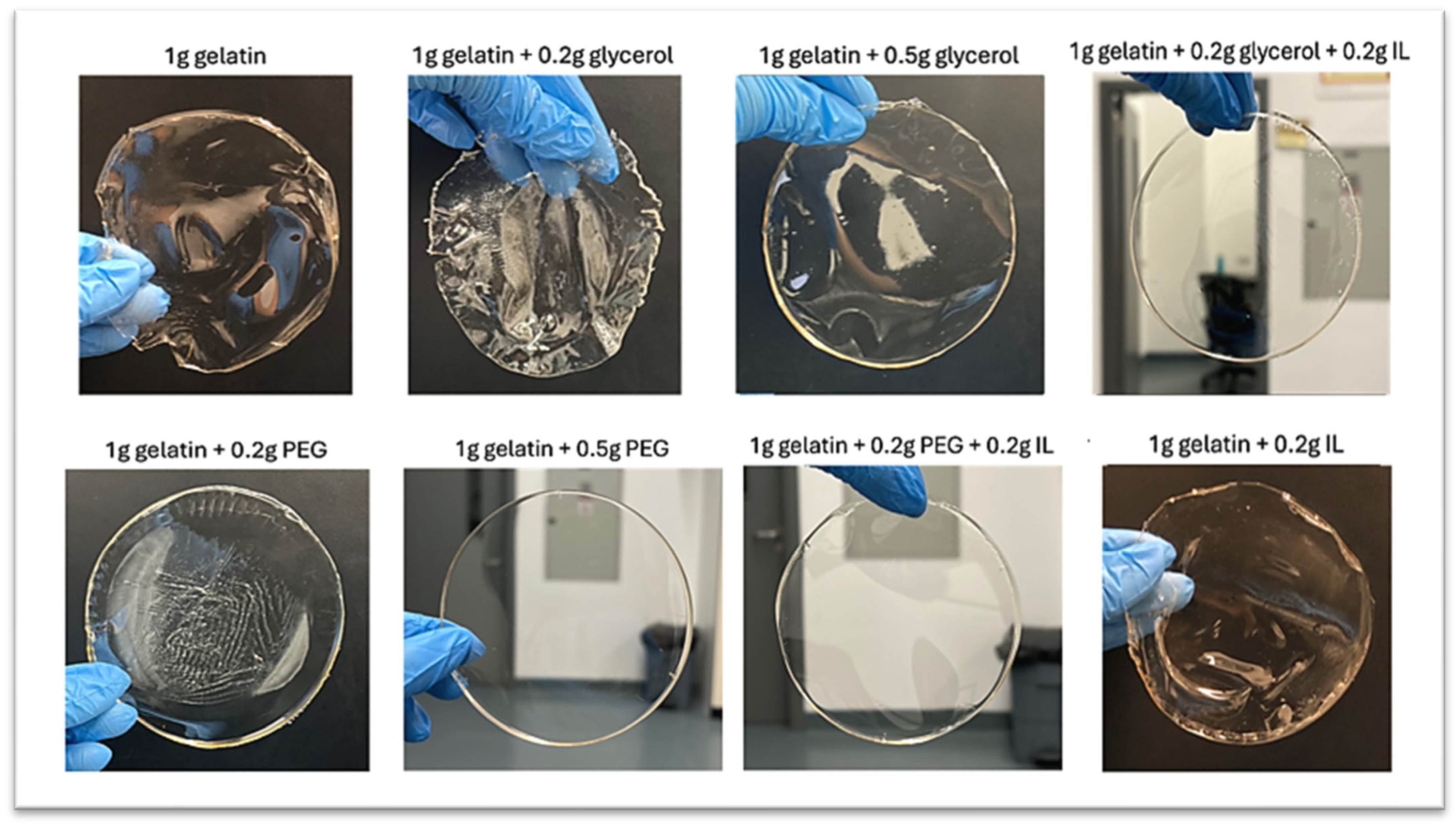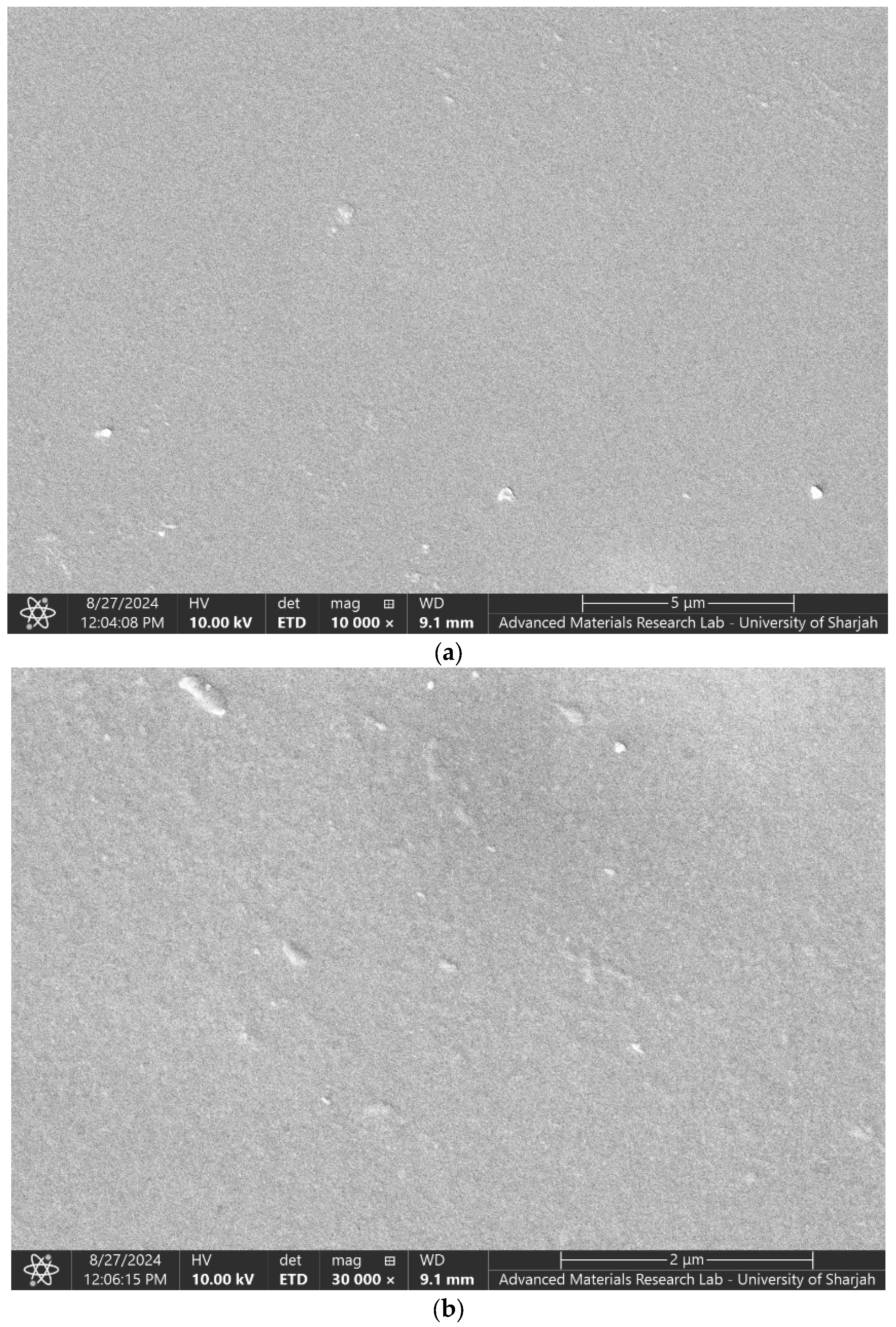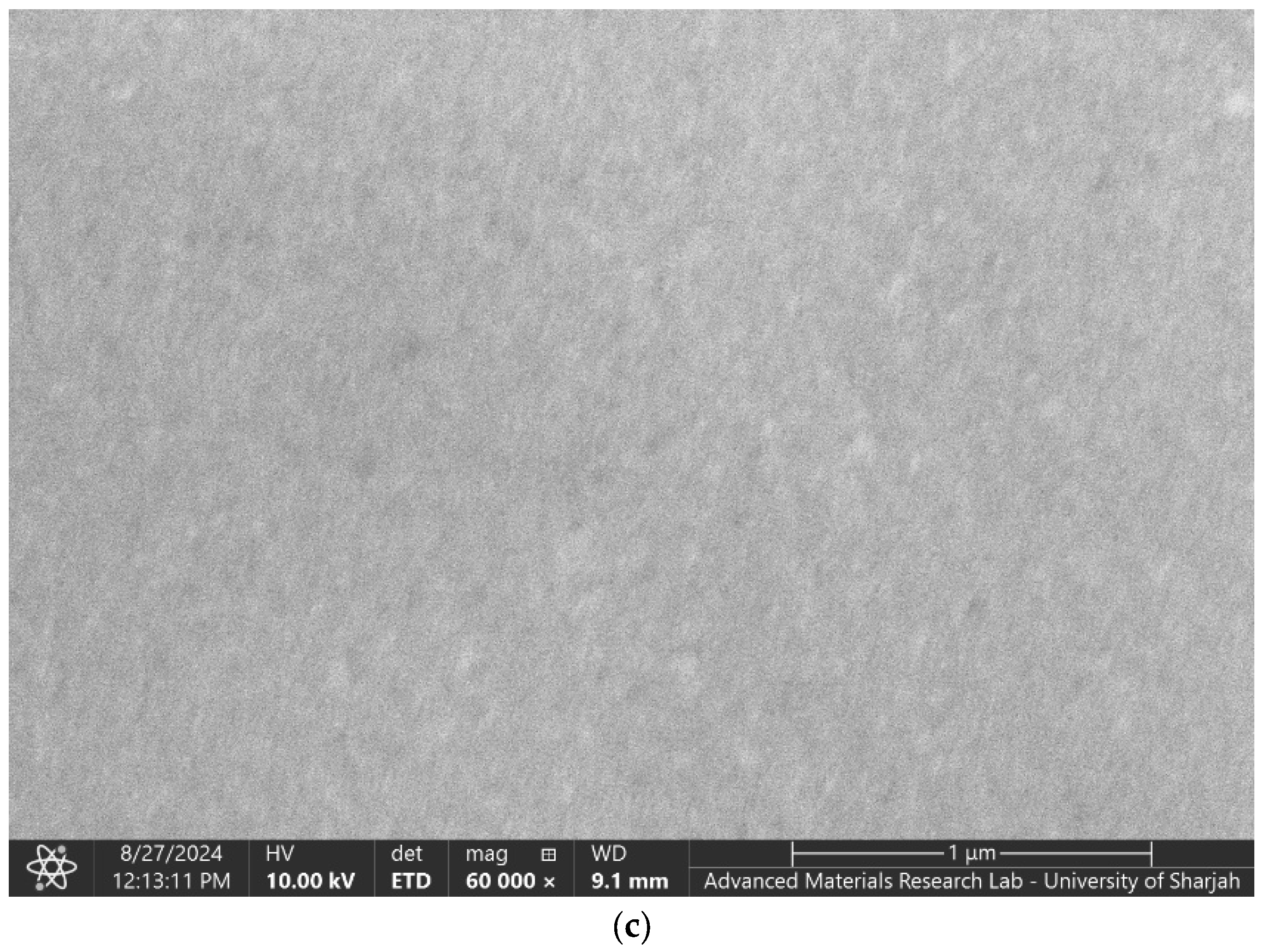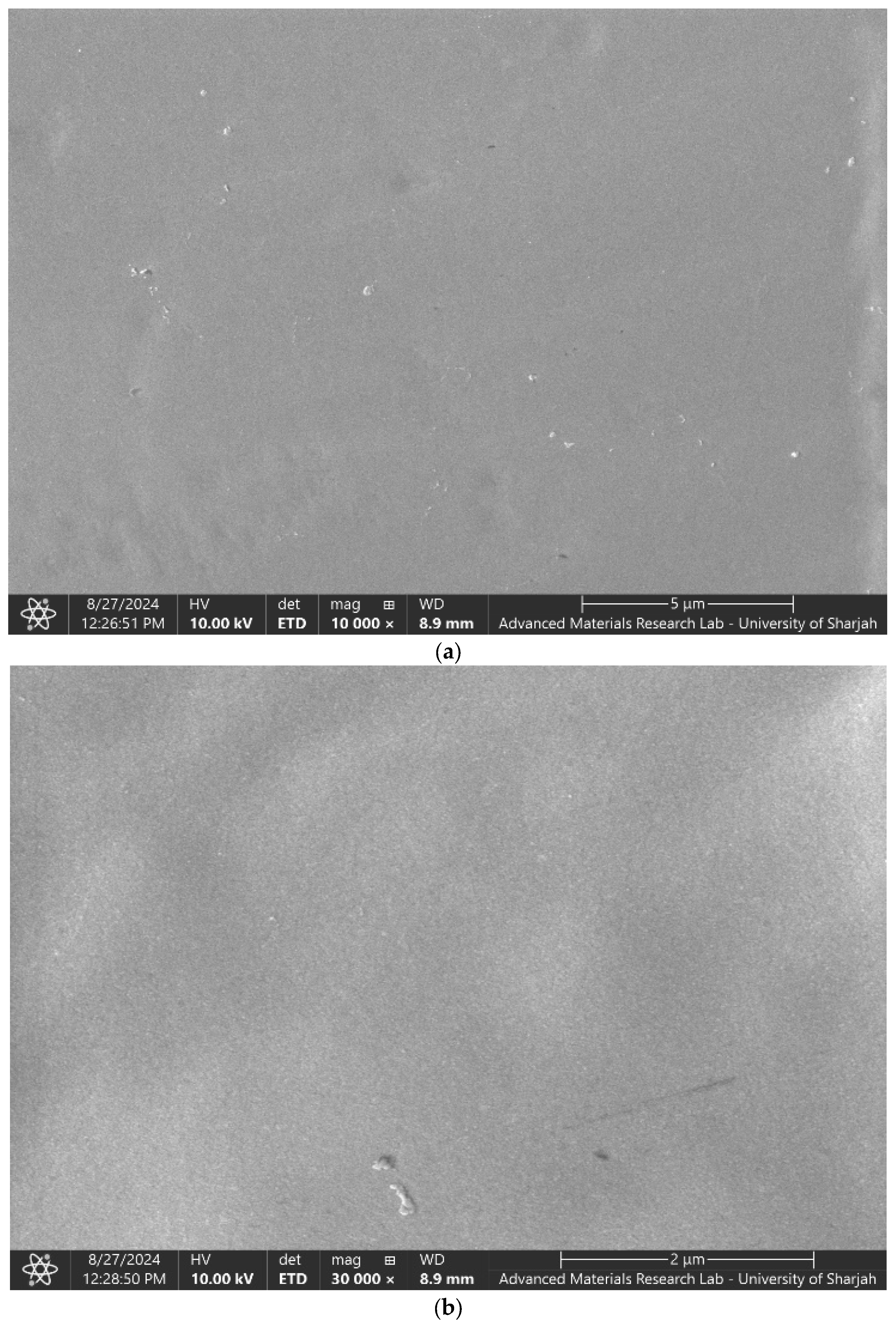Novel Flexible Proton-Conducting Gelatin-Based Green Membranes for Fuel Cell Applications and Flexible Electronics
Abstract
1. Introduction
2. Materials and Methods
2.1. Materials
2.2. Membrane Synthesis
2.3. Characterization Techniques
2.3.1. Electrochemical Impedance Spectroscopy
2.3.2. Water Uptake Test
2.3.3. X-Ray Diffraction
2.3.4. Scanning Electron Microscopy
2.3.5. Energy Dispersive Spectroscopy
3. Results and Discussion
3.1. Electrochemical and Mechanical Performance Results
3.2. Water Uptake Results
3.3. X-Ray Diffraction Results
3.4. Scanning Electron Microscopy Results
3.5. Energy Dispersive Spectroscopy Results
4. Conclusions
Author Contributions
Funding
Data Availability Statement
Acknowledgments
Conflicts of Interest
References
- Abdelkareem, M.A.; Elsaid, K.; Wilberforce, T.; Kamil, M.; Sayed, E.T.; Olabi, A. Environmental aspects of fuel cells: A review. Sci. Total Environ. 2021, 752, 141803. [Google Scholar] [CrossRef]
- Ramani, V. Fuel Cells. Electrochem. Soc. Interface 2006, 15, 41–44. [Google Scholar] [CrossRef]
- Mehdipour-Ataei, S.; Mohammadi, M. Stationary and Portable Applications of Proton Exchange Membrane Fuel Cells. In Proton Exchange Membrane Fuel Cells; Wiley: Hoboken, NJ, USA, 2023; pp. 1–16. [Google Scholar] [CrossRef]
- Kunusch, C.; Puleston, P.; Mayosky, M. PEM Fuel Cell Systems. In Sliding-Mode Control of PEM Fuel Cells; Springer: London, UK, 2012; pp. 13–33. [Google Scholar] [CrossRef]
- Bautista-Rodríguez, C.M.; Bañuelos, J.A.; de la Luz-Pedro, A.; Santoyo, M.M.; Lindeke, R.R. Experimental study and comparison of different geometric configurations in the reactive gases feeding of a PEMFC. Int. J. Electrochem. Sci. 2018, 13, 4223–4242. [Google Scholar] [CrossRef]
- Ahmed, T.M.; Al Othman, A.; Shamayleh, A.; Tawalbeh, M. Water management and conductivity studies in novel polymer zirconium-based membranes for PEM fuel cells. Case Stud. Chem. Environ. Eng. 2025, 11, 101081. [Google Scholar] [CrossRef]
- Tawalbeh, M.; Nimir, W.; Al-Othman, A.; Ka’ki, A. High proton conduction in zirconium silicate/lignin/ionic liquids based- membranes for high temperature PEM fuel cells. Process Saf. Environ. Prot. 2024, 190, 779–791. [Google Scholar] [CrossRef]
- Hassan, M.F.; Al-Othman, A.; Tawalbeh, M.; Ka’ki, A.; Mohamad, S. Novel chitosan-ionic liquid immobilized membranes for PEM fuel cells operating above the boiling point of water. Int. J. Hydrogen Energy 2024, 53, 592–601. [Google Scholar] [CrossRef]
- Bai, H.; Wang, X.; Zhou, Y.; Zhang, L. Preparation and characterization of poly(vinylidene fluoride) composite membranes blended with nano-crystalline cellulose. Prog. Nat. Sci. Mater. Int. 2012, 22, 250–257. [Google Scholar] [CrossRef]
- Rath, R.; Kumar, P.; Rana, D.; Mishra, V.; Kumar, A.; Mohanty, S.; Nayak, S. Sulfonated PVDF nanocomposite membranes tailored with graphene oxide nanoparticles: Improved proton conductivity and membrane selectivity thereof. J. Mater. Sci. 2022, 57, 3565–3585. [Google Scholar] [CrossRef]
- Kumar, P.; Bharti, R.P.; Kumar, V.; Kundu, P.P. Polymer Electrolyte Membranes for Microbial Fuel Cells: Part A. Nafion-Based Membranes. In Progress and Recent Trends in Microbial Fuel Cells; Elsevier: Amsterdam, The Netherlands, 2018; pp. 47–72. [Google Scholar] [CrossRef]
- Ke, A.; Xu, G.; Liu, Y.; Zuo, Y.; Yang, X.; Dong, Y.; Wang, J.; Zheng, J.; Li, J.; Cai, W. Enabling high-temperature application of Nafion membrane via imitating ionic clusters in proton conduction channels. Int. J. Hydrogen Energy 2024, 56, 330–337. [Google Scholar] [CrossRef]
- Berber, M.R.; Hafez, I.H. Boosting the proton conductivity, chemical stability, and fuel cell performance of Nafion membrane at high operating temperatures and low humidity levels by incorporating phytic acid. Int. J. Hydrogen Energy 2024, 57, 1126–1138. [Google Scholar] [CrossRef]
- Ali, A.A.; Al-Othman, A.; Tawalbeh, M. Exploring natural polymers for the development of proton exchange membranes in fuel cells. Process Saf. Environ. Prot. 2024, 189, 1379–1401. [Google Scholar] [CrossRef]
- Abouricha, S.; Aziam, H.; Noukrati, H.; Sel, O.; Saadoune, I.; Lahcini, M.; Youcef, H. Biopolymers-Based Proton Exchange Membranes For Fuel Cell Applications: A Comprehensive Review. ChemElectroChem 2024, 11, e202300648. [Google Scholar] [CrossRef]
- Qiao, D.; Huang, Y.; Hou, X.; Ye, F.; Wu, K.; Jiang, F.; Zhao, G.; Zhang, B.; Xie, F. Enhancing thermal stability and mechanical resilience in gelatin/starch composites through polyvinyl alcohol integration. Carbohydr. Polym. 2024, 344, 122528. [Google Scholar] [CrossRef] [PubMed]
- Patra, R.; Ghosal, K.; Saha, R.; Sarkar, P.; Chattopadhyay, S.; Sarkar, K. Advances in the Development of Biodegradable Polymeric Materials for Biomedical Applications with Respect to Their Synthesis Procedures, Degradation Properties, Toxicity, Stability and Applications. In Encyclopedia of Materials: Plastics and Polymers; Elsevier: Amsterdam, The Netherlands, 2022; pp. 567–592. [Google Scholar] [CrossRef]
- Hanani, Z.A.N.; Roos, Y.H.; Kerry, J.P. Use and application of gelatin as potential biodegradable packaging materials for food products. Int. J. Biol. Macromol. 2014, 71, 94–102. [Google Scholar] [CrossRef] [PubMed]
- Hanani, Z.A.N. Gelatin. In Encyclopedia of Food and Health; Elsevier: Amsterdam, The Netherlands, 2016; pp. 191–195. [Google Scholar] [CrossRef]
- Mushtaq, F.; Raza, Z.; Batool, S.; Zahid, M.; Onder, O.; Rafique, A.; Nazeer, M. Preparation, properties, and applications of gelatin-based hydrogels (GHs) in the environmental, technological, and biomedical sectors. Int. J. Biol. Macromol. 2022, 218, 601–633. [Google Scholar] [CrossRef] [PubMed]
- Şener Raman, T.; Kuehnert, M.; Daikos, O.; Scherzer, T.; Krömmelbein, C.; Mayr, S.; Abel, B.; Schulze, A. A study on the material properties of novel PEGDA/gelatin hybrid hydrogels polymerized by electron beam irradiation. Front. Chem. 2023, 10, 1094981. [Google Scholar] [CrossRef]
- Hu, Y.; Maimaitiyiming, X. Gelatin/sodium alginate-based strongly adhesive, environmentally resistant, highly stable hydrogel for 3D printing to prepare multifunctional sensors and flexible supercapacitors. Int. J. Biol. Macromol. 2024, 278, 134712. [Google Scholar] [CrossRef]
- Xiao, B.H.; Xiao, K.; Li, J.X.; Xiao, C.F.; Cao, S.; Liu, Z.Q. Flexible electrochemical energy storage devices and related applications: Recent progress and challenges. Chem. Sci. 2024, 15, 11229–11266. [Google Scholar] [CrossRef]
- Yuan, Y.; Cheng, M.; Jing, H.; Hu, J.; Liu, Q.; Wei, T.; Wang, R.; Liu, B. In-situ cross-linking construction of gelatin based phase change aerogel toward advanced thermal energy conversion and storage. J. Energy Storage 2024, 93, 112423. [Google Scholar] [CrossRef]
- Landi, G.; La Notte, L.; Palma, A.L.; Puglisi, G. Electrochemical Performance of Biopolymer-Based Hydrogel Electrolyte for Supercapacitors with Eco-Friendly Binders. Polymers 2022, 14, 4445. [Google Scholar] [CrossRef]
- Sonwane, S.; Bonde, S.; Bonde, C.; Chandarana, C. Advances in Gelatin-based Scaffolds for Tissue Engineering Applications: A Review. J. Drug Deliv. Sci. Technol. 2025, 107, 106789. [Google Scholar] [CrossRef]
- Hivechi, A.; Yousefmoumji, H.; Bahrami, S.H.; Brouki Milan, P. Fabrication and characterization of in situ gelling oxidized carboxymethyl cellulose/gelatin nanofibers for wound healing applications. Int. J. Biol. Macromol. 2025, 298, 140033. [Google Scholar] [CrossRef]
- Huner, A. Fast-dissolving electroactive drug delivery systems: Gelatin/Poly(sulphonic acid diphenyl aniline) electrospun nanofibers. Food Biosci. 2024, 61, 104924. [Google Scholar] [CrossRef]
- Wang, S.; Shi, L.; Zhang, S.; Wang, H.; Cheng, B.; Zhuang, X.; Li, Z. Proton-conducting amino acid-modified chitosan nanofibers for nanocomposite proton exchange membranes. Eur. Polym. J. 2019, 119, 327–334. [Google Scholar] [CrossRef]
- Zhu, L.; Yang, H.; Xu, T.; Wang, L.; Lei, J.; Si, C. Engineered Nanochannels in MXene Heterogeneous Proton Exchange Membranes Mediated by Cellulose Nanofiber/Sodium Alginate Dual Crosslinked Networks. Adv. Funct. Mater. 2024, 35, 2419334. [Google Scholar] [CrossRef]
- Obasi, L.A.; Onukwuli, O.D.; Okoye, C.C. Performance of microbial fuel cell operating with clay-manihot starch composite proton exchange membrane using RSM. Curr. Res. Green Sustain. Chem. 2021, 4, 100117. [Google Scholar] [CrossRef]
- Der, O.; Alqahtani, A.A.; Marengo, M.; Bertola, V. Characterization of polypropylene pulsating heat stripes: Effects of orientation, heat transfer fluid, and loop geometry. Appl. Therm. Eng. 2021, 184, 116304. [Google Scholar] [CrossRef]
- Der, O.; Marengo, M.; Bertola, V. Thermal Performance of Pulsating Heat Stripes Built with Plastic Materials. J. Heat Transf. 2019, 141, 091808. [Google Scholar] [CrossRef]
- Wu, W.; Yu, D.; Luo, Y.; Guan, X.; Zhang, S.; Ma, G.; Zhou, X.; Li, C.; Wang, S. Introduction of polymeric ionic liquids containing quaternary ammonium groups to construct high-temperature proton exchange membranes with high proton conductivity and stability. J. Colloid Interface Sci. 2024, 675, 689–699. [Google Scholar] [CrossRef]
- Nimir, W.; Al-Othman, A.; Tawalbeh, M. Unveiling zirconium phytate-heteropolyacids-ionic liquids membranes for PEM fuel cells applications up to 150 °C. Int. J. Hydrogen Energy 2025, 107, 3–14. [Google Scholar] [CrossRef]
- Díaz, M.; Ortiz, A.; Ortiz, I. Progress in the use of ionic liquids as electrolyte membranes in fuel cells. J. Membr. Sci. 2014, 469, 379–396. [Google Scholar] [CrossRef]
- Wu, P.; Imai, M. Excellent dyes removal and remarkable molecular size rejection of novel biopolymer composite membrane. Desalination Water Treat. 2013, 51, 5237–5247. [Google Scholar] [CrossRef]
- Tawalbeh, M.; Al-Othman, A.; Ka’ki, A.; Farooq, A.; Alkasrawi, M. Lignin/zirconium phosphate/ionic liquids-based proton conducting membranes for high-temperature PEM fuel cells applications. Energy 2022, 260, 125237. [Google Scholar] [CrossRef]
- Frydrych, M.; Wan, C.; Stengler, R.; O’Kelly, K.U.; Chen, B. Structure and mechanical properties of gelatin/sepiolite nanocomposite foams. J. Mater. Chem. 2011, 21, 9103. [Google Scholar] [CrossRef]
- Sun, H.; Wang, S.; Wang, X.; Pan, F.; Li, C.; Yu, D.; Luo, Y.; Wang, Z. Branched polybenzimidazole/polymeric ionic liquid crosslinked membranes with high proton conductivity and oxidation stability for HT-PEMFCs. Int. J. Hydrogen Energy 2024, 61, 883–892. [Google Scholar] [CrossRef]
- Fawale, O.; Abuibaid, A.; Hamed, F.; Kittiphattanabawon, P.; Maqsood, S. Molecular, Structural, and Rheological Characterization of Camel Skin Gelatin Extracted Using Different Pretreatment Conditions. Foods 2021, 10, 1563. [Google Scholar] [CrossRef]
- López-Angulo, D.; Bittante, A.; Luciano, C.; Ayala-Valencia, G.; Flaker, C.; Djabourov, M.; José do Amaral Sobral, P. Effect of Laponite® on the structure, thermal stability and barrier properties of nanocomposite gelatin films. Food Biosci. 2020, 35, 100596. [Google Scholar] [CrossRef]
- Shamshina, J.L.; Berton, P. Ionic Liquids as Designed, Multi-Functional Plasticizers for Biodegradable Polymeric Materials: A Mini-Review. Int. J. Mol. Sci. 2024, 25, 1720. [Google Scholar] [CrossRef]











| Composition | t (cm) | (Scm−1) | Elasticity | ||
|---|---|---|---|---|---|
| 1 | 1 g Gelatin | 0.010 | 122.8 | 1.0368 × 10−4 | Bendable and not stretchable |
| 2 | 1 g Gelatin + 0.2 g glycerol | 0.006 | 118.4 | 6.452 × 10−5 | Bendable and stretchable |
| 3 | 1 g Gelatin + 0.5 g glycerol | 0.016 | 64.12 | 3.1771 × 10−4 | Bendable and stretchable |
| 4 | 1 g Gelatin + 0.2 g glycerol + 0.2 g IL | 0.005 | 39.59 | 1.6080 × 10−4 | Bendable and stretchable |
| 5 | 1 g Gelatin + 0.2 g PEG | 0.015 | 79.12 | 2.4139 × 10−4 | Bendable and stretchable |
| 6 | 1 g Gelatin + 0.5 g PEG | 0.020 | 133.4 | 1.9089 × 10−4 | Bendable and stretchable |
| 7 | 1 g Gelatin + 0.2 g PEG + 0.2 g IL | 0.015 | 9.524 | 2.0053 × 10−4 | Bendable and stretchable |
| 8 | 1 g Gelatin + 0. 2 g IL | 0.024 | 73.08 | 4.181 × 10−4 | Bendable and stretchable |
Disclaimer/Publisher’s Note: The statements, opinions and data contained in all publications are solely those of the individual author(s) and contributor(s) and not of MDPI and/or the editor(s). MDPI and/or the editor(s) disclaim responsibility for any injury to people or property resulting from any ideas, methods, instructions or products referred to in the content. |
© 2025 by the authors. Licensee MDPI, Basel, Switzerland. This article is an open access article distributed under the terms and conditions of the Creative Commons Attribution (CC BY) license (https://creativecommons.org/licenses/by/4.0/).
Share and Cite
Tawalbeh, M.; Abdulraqeb Ali, A.; Magdi Ahmed, T.; Al-Othman, A. Novel Flexible Proton-Conducting Gelatin-Based Green Membranes for Fuel Cell Applications and Flexible Electronics. Processes 2025, 13, 2753. https://doi.org/10.3390/pr13092753
Tawalbeh M, Abdulraqeb Ali A, Magdi Ahmed T, Al-Othman A. Novel Flexible Proton-Conducting Gelatin-Based Green Membranes for Fuel Cell Applications and Flexible Electronics. Processes. 2025; 13(9):2753. https://doi.org/10.3390/pr13092753
Chicago/Turabian StyleTawalbeh, Muhammad, Amaal Abdulraqeb Ali, Tallah Magdi Ahmed, and Amani Al-Othman. 2025. "Novel Flexible Proton-Conducting Gelatin-Based Green Membranes for Fuel Cell Applications and Flexible Electronics" Processes 13, no. 9: 2753. https://doi.org/10.3390/pr13092753
APA StyleTawalbeh, M., Abdulraqeb Ali, A., Magdi Ahmed, T., & Al-Othman, A. (2025). Novel Flexible Proton-Conducting Gelatin-Based Green Membranes for Fuel Cell Applications and Flexible Electronics. Processes, 13(9), 2753. https://doi.org/10.3390/pr13092753









